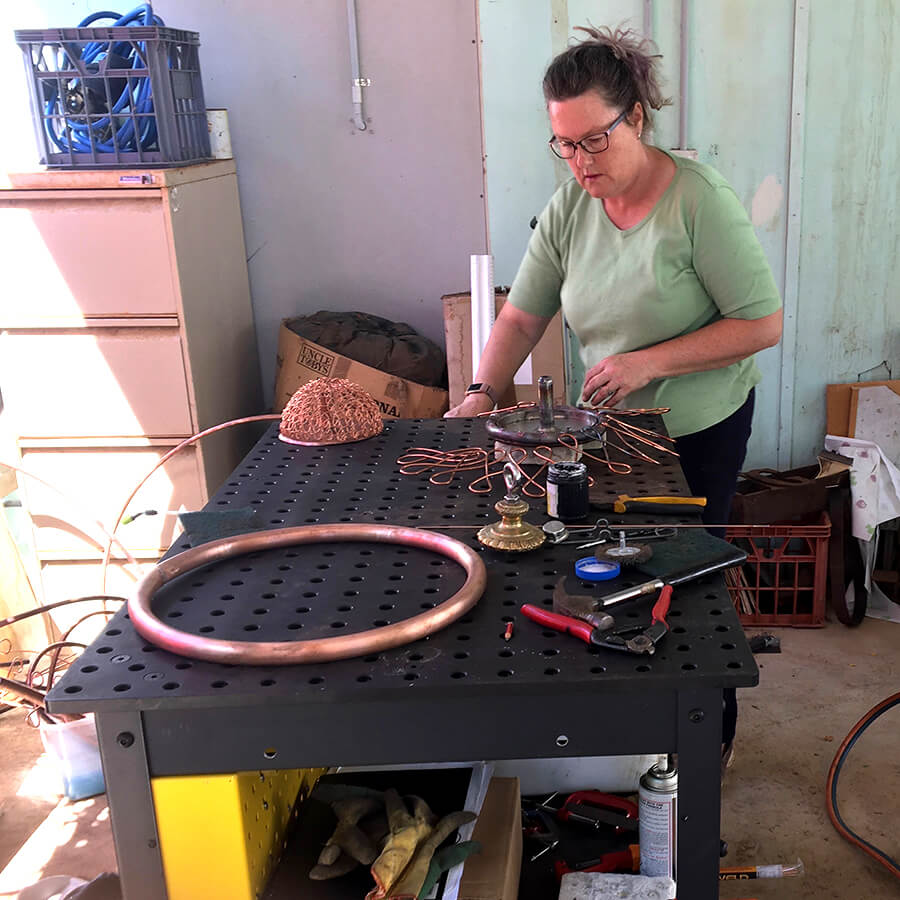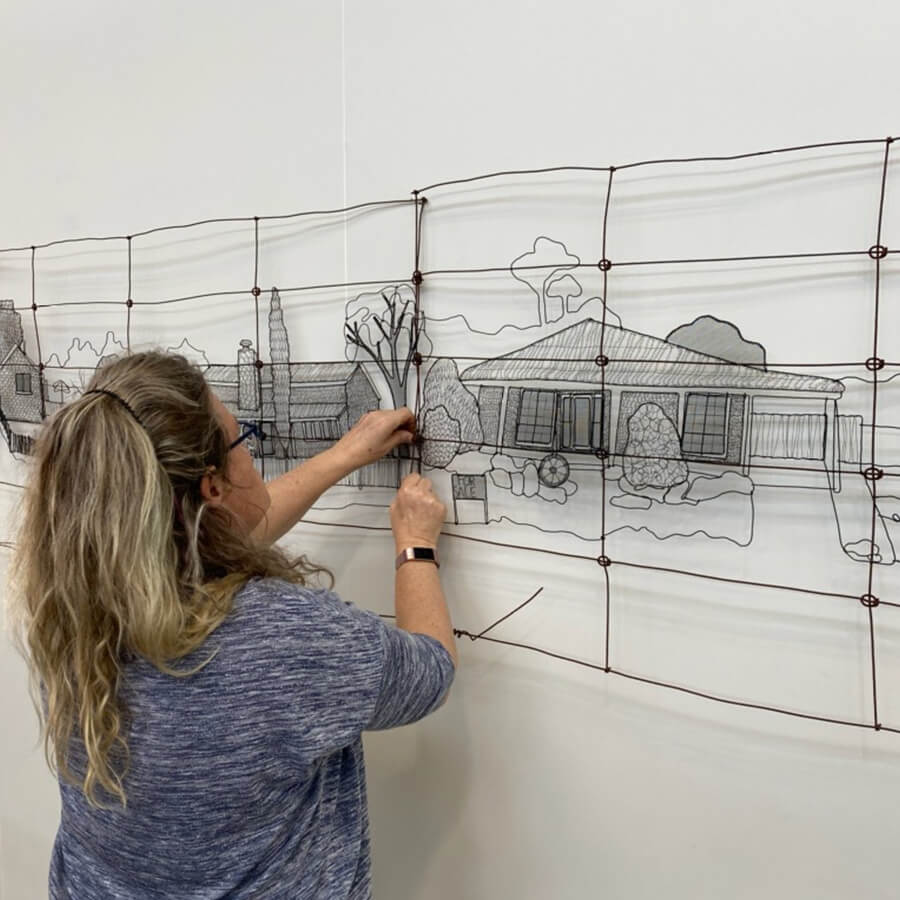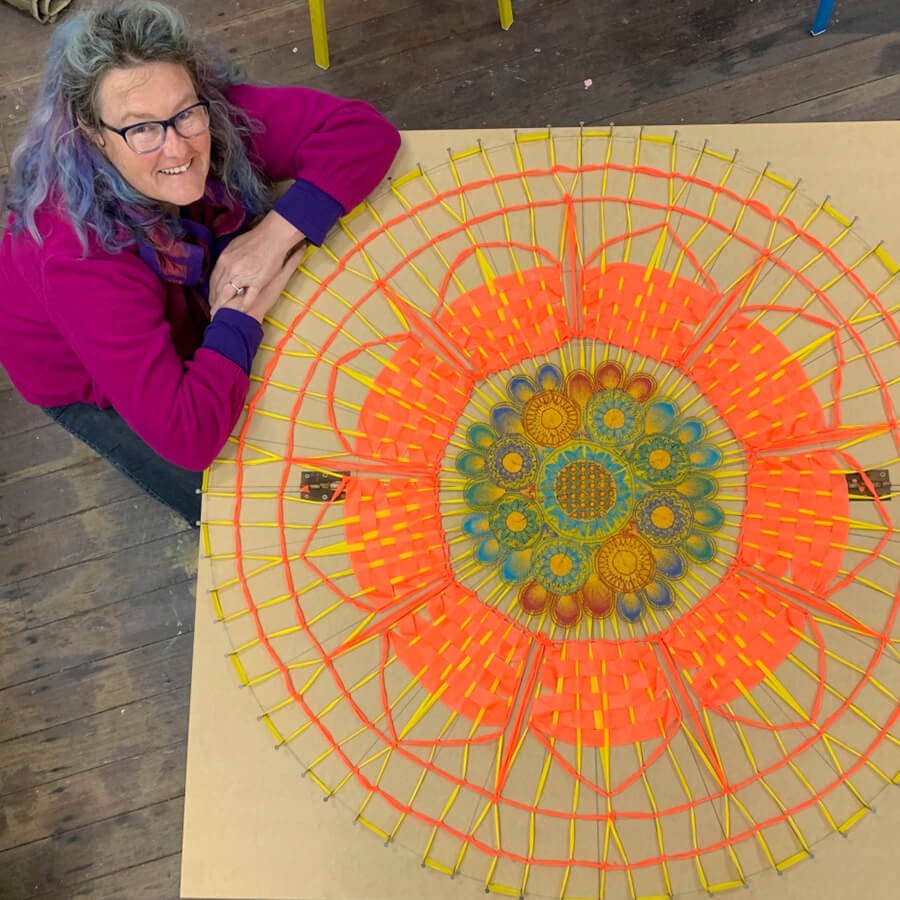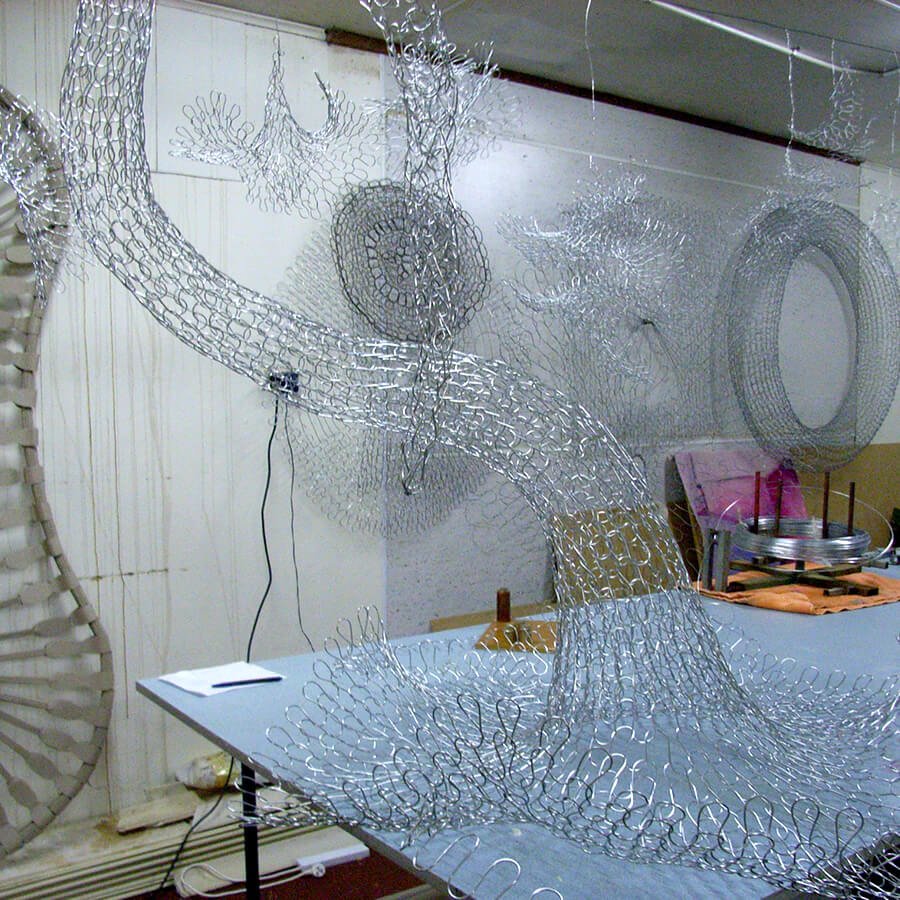About Tania Spencer
Australian Wire Artist
Tania Spencer works out of her studio in Lake Grace, Western Australia. Although often working with wire, Tania does work with found and recycled materials. While her work is deceptively simple in its form, the underlying social or environmental context, constantly questions our state of existence and awareness.
She has exhibited since 2000 in group shows regionally as well as Perth, Adelaide, Sydney, and Japan, and her first solo exhibition in 2007 was in the Access Gallery, John Curtin Gallery, Curtin University, Perth, WA as the result of receiving the Curtin Guild Grant “On Show”.
Tania currently creates large-scale knitted installations constructed with fencing wire and wire embroideries that are couched onto metal supports. Her tools are drills and hand bending jigs instead of needles, wire instead of yarn. Tania’s practice honours the hand makers’ mark in the technological age by valuing the practice of the passing on of hand-making skills through the generations. In attempting to create archival textiles, Tania’s work addresses questions within the art/craft and gender debates by mixing soft textile processes with rural industrial materials and investigates the underlying human relationships in societal and environmental concerns.
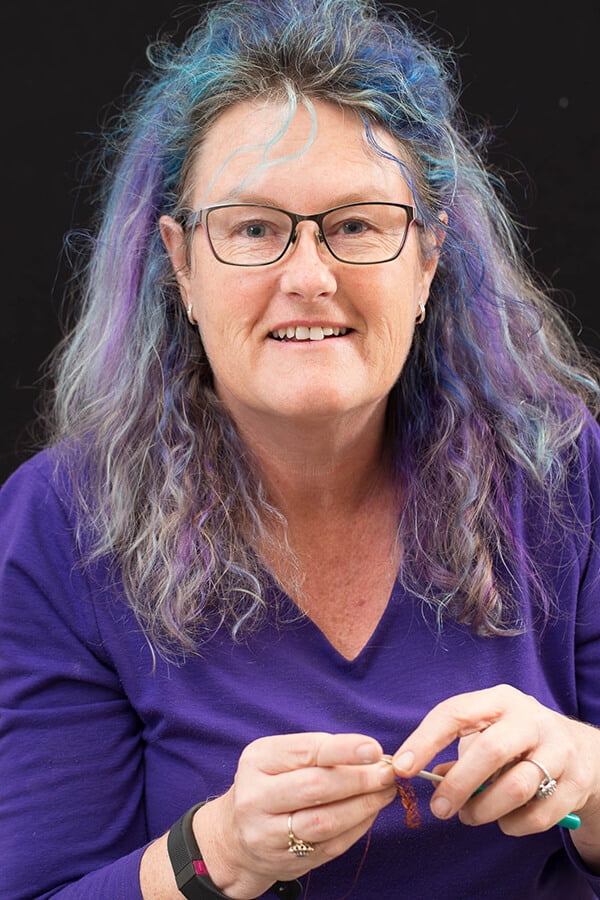
Tania Spencer Biography
Tania has a Bachelor of Arts (Art) from Curtin University and has participated in numerous art events including the Melville Art Awards, winning the 2006 Overall Judges Choice, the City of Melville Sculpture Walk (2007 and 2008), Castaways Sculpture Awards 2007 & 2010-11, winning the Castaways Alcoa Major Sculpture Award in 2010.
She is a nine-time exhibitor with Sculpture by the Sea, winning both the NAB WA Sculptors Scholarship and Kids Choice at Sculpture by the Sea, Cottesloe in 2008. In 2009 Tania was commissioned to create a sculpture at Northcliffe, WA, for the Understory-Art In Nature Sculpture walk. She exhibited in Mine Own Executioner & the Bunbury Biennale 10 Year Retrospective in 2011.
Recent national exhibitions include Love Lace, The International Lace Award at the Powerhouse Museum in Sydney, and Sensorial Loop, the 1st Textile Triennial in Tamworth, New South Wales.
She has had a number of solo exhibitions in Western Australia including Seeking Insight…Unity? (John Curtin Gallery, 2007); Searching (Kalgoorlie Mining Hall of Fame, 2008) and Introspective – Works from 2006-2008 (Painted Tree Gallery, Northcliffe, 2009) and Earth Stories in 2020. In 2011 she was awarded a Clitheroe Foundation Mentorship to work with Brian McKay and an Artstart Grant by the Australia Council.
Her work is represented in the Tamworth Regional Council Textile Collection, City of Melville(2006 &2008) Nedlands and City of Bunbury Art Collections, Understory-Northcliffe Sculpture Walk, Gomboc Gallery and Sculpture Park, and various private collections.
Tania has been a Sessional Lecturer for Curtin Regional University Campuses and has taught over 50 community and school arts workshops throughout Western Australia. She is the co-owner of the Lake Grace Regional Artspace, a community-run artist gallery and workshop which was established to promote Wheatbelt artists and deliver innovative arts experiences in a regional capacity.
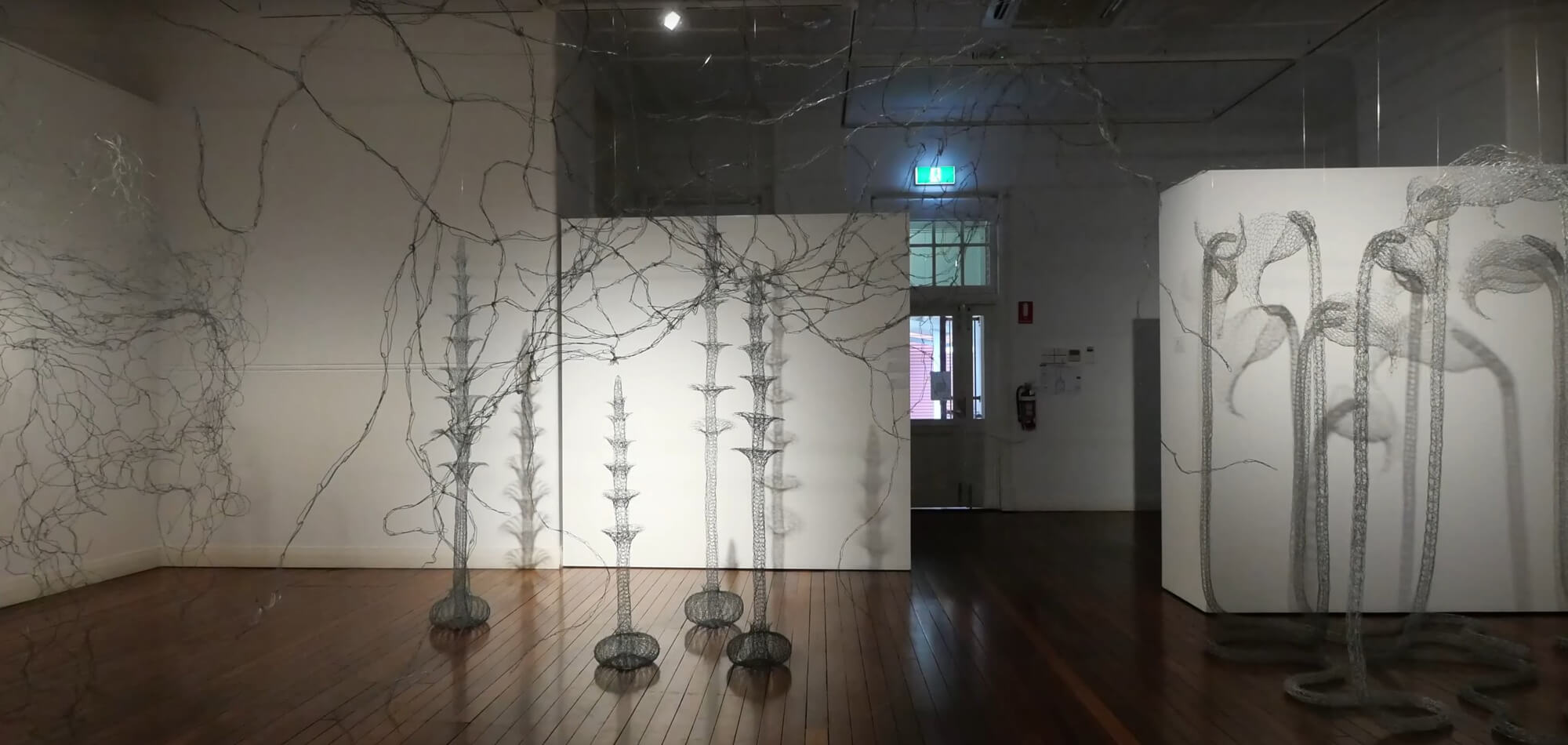
Artist Statement
I grew up on a wheat and sheep farm with the usual obligatory machinery tip, containing everything used on the farm since settlement of the land. Farm tips are not tips in the usual sense; they really are the earliest of recycling yards. It was called the junk heap on our farm and everything in it had the potential for reuse. My father would scour the junk heap for the right bit of metal for the current invention in progress; usually something to make life easier or more efficient on the farm. As children we played here frequently.
Now on our own farm, this, along with the farm supplies shop, hardware shop, and the town tip, are my favourite resources for materials. Mostly materials that can be collected or sourced within a relatively local environment find their way into my art.
My present knitted work is a blend of the ancient process of nalbinding (also known as ‘knotless knitting’ or ’single needle knitting’) viking knit and more recent knitting techniques along with a healthy dose of invention.
I have been surrounded by textiles and textile process from from an early age, learning to knit and crochet from Mum and Nanna and embroidery and macrame from the ladies of the CWA. Then to growing wool, working in shearing sheds and later on garment manufacturing in the textile industry and retail clothing. Textiles is the interlocking thread through my life and my art.
I was 8yrs old when my father gave me a roll of copper wire recycled from a small electric motor he had pulled apart. He bought me my own pair of needle nose pliers, the smallest he could find for my little hands. Combining textile process with alternative linear materials was a natural progression after studying textile units while at Curtin. Therefore as a consequence of these two influences most of my work is grounded in textile techniques or methods and constructed with industrial agricultural materials in a celebration of my heritage .
The subjects I revisit my work are emotional and physical relationships; the examination of our existence, physically and spiritually and environmentally. Observations of life, in relation to ourselves and each other within both the natural and social environment and the impact and connections that these interactions have, guides my practice. Societal issues like belief systems, social conditioning, identity, polarities in opinions and our impact on ecological systems become subjects for my work.
I consider the linear quality of the wire and how I form it as metaphor for how we are linked together, each stitch depending on the other for support. The collective stitches make a strong fabric. The interlinked areas and openings reflect the degrees of closeness or distance that we have with families, friends and the greater physical environment.
I try to build layers of inherited or implied meaning from different perspectives into my work so that it is accessible in a number of ways and this is the ultimate aim.



